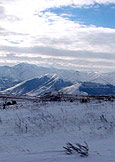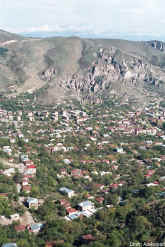|

|
From the Sisian-Goris highway,
a signposted road turns S to
Harzhis, which is perched above the Vorotan Gorge
among rolling volcanic uplands. About
half way to Harzhis, where the power pylons cross the road, a dirt road leads back NNW to the
substantial
remains of the “Kotrats
Caravansaray”, built in 1319 by the Orbelian family
as a
way point on the
Silk Road. The
|
|
Coming from the W, turn right just before the bridge to enter the town of Goris, which sprawls out along the gorge of the
Goris River.
Goris is famous for its fierce home-made fruit vodkas, its honey,
and for the medieval cave-dwellings carved out of the
soft volcanic tuff
in the
southern part of town.
Goris is home to
the
Axel
Bakunts
house museum,
|

|
|
Armenian inscription over the door is badly
weathered, but a Persian inscription survives above it. There are
also standing stones of an early Iron Age cemetery nearby. An Aramaic
inscription was found nearby. Beyond
Harzhis, a rough dirt road continues SE to Shinuhayr, passing remains of
a medieval hamlet on the edge of the gorge. There are
castle remains somewhere nearby. Deep inside the gorge below Harzhis is a 13th c.
bridge over the Vorotan.
|
|
commemorating one of Armenia’s great prose
writers, who died in prison in 1937, paying a delayed price for
“nationalist deviationism” and past Dashnak sympathies. There is a
regional
museum as well, and new busts of some of the Dashnak leaders of
Zangezur's resistance from 1918-21, first to Azerbaijani territorial
aspirations and then to the Red Army. In November 1919, Armenian troops from
Goris under Lt. Col. Arsen
Shahmazian repelled a major but unadmitted Azeri push from
Lachin
and Hajilar to seize
Zangezur,
and thus assured Armenia's land link to Iran and Nakhichevan's
status as exclave.
|